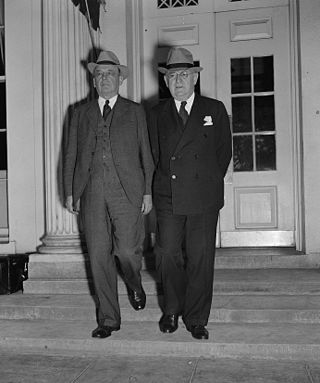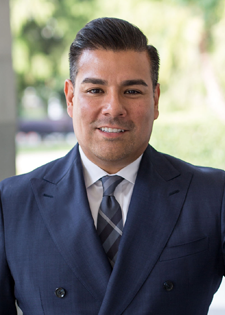The United States federal executive departments are the principal units of the executive branch of the federal government of the United States. They are analogous to ministries common in parliamentary or semi-presidential systems but they are led by a head of government who is also the head of state. The executive departments are the administrative arms of the president of the United States. There are currently 15 executive departments.

The Kentucky Transportation Cabinet (KYTC) is Kentucky's state-funded agency charged with building and maintaining federal highways and Kentucky state highways, as well as regulating other transportation related issues.

The President's Committee on Administrative Management, commonly known as the Brownlow Committee or Brownlow Commission, was a presidentially-commissioned panel of political science and public administration experts that in 1937 recommended sweeping changes to the executive branch of the United States government. The committee had three members: Louis Brownlow, Charles Merriam, and Luther Gulick. The staff work was managed by Joseph P. Harris, director of research for the committee.

The Public Service Commission, called the State Services Commission until 2020, is the central public service department of New Zealand charged with overseeing, managing, and improving the performance of the state sector of New Zealand and its organisations.

The California executive branch consists of elected officers and other offices and officers. The elected executive officers are:

The Cabinet of the governor of Oklahoma is a body of the most senior appointed officials of the executive branch of the government of Oklahoma. Originally an informal meeting between the governor of Oklahoma and various government officials, the Governor's Cabinet has evolved into an important information link between the governor and the various agencies, boards and commissions that operate within state government.

The Oklahoma State Department of Education is the state education agency of the State of Oklahoma charged with determining the policies and directing the administration and supervision of the public school system of Oklahoma. The State Board of Education, the governing body of the Department, is composed of the Oklahoma State Superintendent of Public Instruction and six members appointed by the Governor of Oklahoma with the approval of the Oklahoma Senate. The State Superintendent, in addition to serving as chair of the Board, serves as the chief executive officer of the Department and is elected by the voters of Oklahoma every four years.

The Oklahoma Office of Personnel Management (OPM) was an agency of the government of Oklahoma which was dissolved in 2011. OPM managed the civil service of the state government. OPM previously provided comprehensive human resource services to all state agencies and employees, as well as information for individuals interested in state service careers. OPM, together with the Oklahoma Merit Protection Commission, was responsible for administering and enforcing the State Merit System.
The Administrative Reforms Commission (ARC) is the commission appointed by the Government of India for giving recommendations for reviewing the public administration system of India. The first ARC was established on 5 January 1966. The Administrative Reforms Commission was initially chaired by Morarji Desai, and later on K. Hanumanthaiah became its chairman when Desai became the Deputy Prime Minister of India.
The Michigan Department of Technology, Management & Budget (DTMB), formerly Michigan Department of Management and Budget, is a principal department of the government of Michigan responsible for various support functions within the government.
The Executive Branch Reform Act of 1986 is an Oklahoma state law that requires the Governor of Oklahoma to organize the various 500 or more departments, agencies, boards, commissions and other entities of the state's executive branch into a cabinet system. The act grouped state agencies into clusters with an informational link to a cabinet secretary. But the legislation stopped short of consolidating agencies or the decision-making authority of the agencies, boards and commissions.

The Oklahoma Merit Protection Commission (OMPC) was an independent quasi-judicial agency of the government of Oklahoma established to protect the integrity of state’s merit system utilized by state agencies and their employees. The Commission and the Office of Personnel Management acted independently forming a “checks and balances” method of managing the merit system.
Pamela M. Warren is an American civil servant who served as the Oklahoma Secretary of Administration under Governor of Oklahoma Frank Keating. Warren served as secretary from January 1, 1997, until her retirement from state service in January 2004. In addition to her service as secretary, Warren served as the director of the Oklahoma Department of Central Services during that same time period.

The Oklahoma Secretary of Finance, Administration and Information Technology is a member of the Oklahoma Governor's Cabinet. The Secretary is appointed by the governor, with the consent of the Oklahoma Senate, to serve at the pleasure of the governor. The secretary serves as the chief adviser to the governor on fiscal policy, taxation, and the operations and personnel needs of the state government.

The Oklahoma State Budget for Fiscal Year 2012, is a spending request by Governor Mary Fallin to fund government operations for July 1, 2011–June 30, 2012. Governor Fallin proposed the budget on February 7, 2011. This was Governor Fallin's first budget submitted as governor.
The Committee on Department Methods, popularly known as the Keep Commission, was appointed by President Theodore Roosevelt in 1905. The Commission's members were Charles H. Keep, Assistant Secretary of the Treasury and Chairman of the Commission, James R. Garfield, Gifford Pinchot, Frank H. Hitchcock and Lawrence O. Murray. The Commission represented the first assertion by a President that the President is responsible for administration.

The Oklahoma State Budget for Fiscal Year 2013, is a spending request by Governor Mary Fallin to fund government operations for July 1, 2012–June 30, 2013. Governor Fallin proposed the budget on February 6, 2012. This was Governor Fallin's second budget submitted as governor.

The Wisconsin Department of Children and Families (DCF) is an agency of the Wisconsin state government responsible for providing services to assist children and families and to oversee county offices handling those services. This includes child protective services, adoption and foster care services, and juvenile justice services. It also manages the licensing and regulation of facilities involved in the foster care and day care systems, performs background investigations of child care providers, and investigates incidents of potential child abuse or neglect. It administers the Wisconsin Works (W-2) program, the child care subsidy program, child support enforcement and paternity establishment services, and programs related to the federal Temporary Assistance to Needy Families (TANF) income support program.

The Oklahoma State Budget for Fiscal Year 2015, is a spending request by Governor Mary Fallin to fund government operations for July 1, 2014 – June 30, 2015. Governor Fallin proposed the budget on February 3, 2014. This was Governor Fallin's fourth budget submitted as governor.





